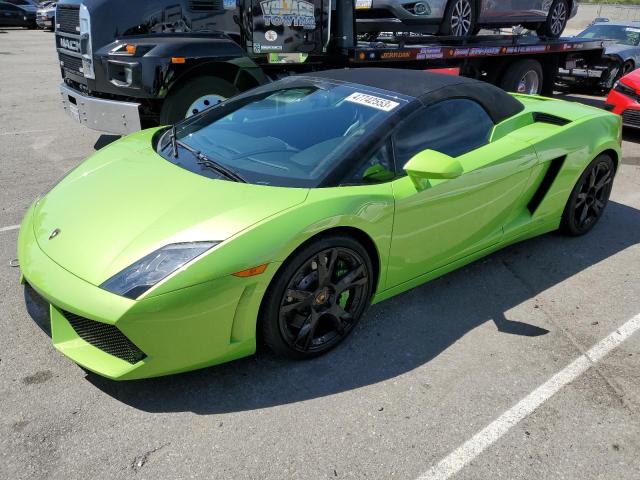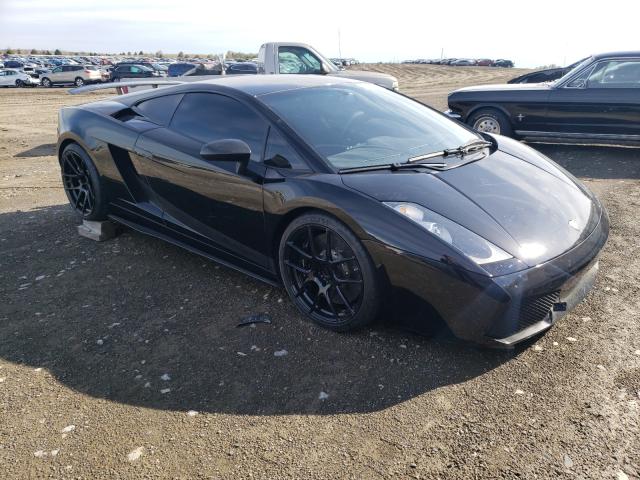2008 LAMBORGHINI GALLARDO | ZHWGU22T48LA05972
Lot details
- Sale Date2020-12-11
- Lot Number58157440
- ACV105200 $
- Sale documentVA - CERTIFICATE OF TITLE
- LocationVA - SANDSTON
- Odometer40,697 miles (65,495 km)
- Primary DamageMINOR DENT/SCRATCHES
Vehicle details
- Make
- Model
- Year2008
- FuelGAS
- Engine5.0L 10
- TransmissionsMANUAL
- Drive TypeAll wheel drive
Vehicle specifications
3
~$240,000
Engine: 5.2L V10
Torque: 540 Nm
0–100 km/h: ~3.4 s
The Lamborghini Gallardo LP570-4 Superleggera was the sharpest, lightest, and most focused Gallardo ever built — a raw-edged celebration of naturally aspirated V10 performance. With 570 hp, carbon fiber body components, 4-wheel drive, and a dry weight of just 1,340 kg, it delivered supercar-level performance with brutal response and theatrical flair.
Its 5.2L V10 screamed to 8,500 rpm, delivering immediate throttle response with no turbo interference. Paired with Lamborghini’s e-gear automated manual or optional 6-speed manual (rare), it offered engaging but aggressive gear changes, especially in Corsa mode.
Compared to earlier Gallardos, the LP570-4 featured upgraded aero (larger diffuser, carbon wing), sharper suspension geometry, and a louder, freer-flowing exhaust. The Superleggera name, meaning “super light”, was earned through use of lightweight glass, forged wheels, and extensive use of CFRP panels.
Despite its wild personality, the Gallardo retained everyday drivability: decent visibility, reliable Audi-based electronics, and optional front axle lift. But with ESC dialed back, it transformed into a track-ready, screaming wedge of Italian aggression.
The Gallardo LP570-4 Superleggera earns its place in the performance registry as Lamborghini’s most focused pre-Huracán model, marking the end of an era for manual V10 exotics and naturally aspirated precision.
Final Bid Lamborghini Gallardo (2008)
$27,100
$48,547
$66,000
Body Styles
The Gallardo was offered in two main body styles: the Coupe, with its sharp-edged wedge profile and mid-engine proportions, and the Spyder, introduced in 2006 with an electrohydraulic soft top and reinforced chassis. Later Superleggera and Performante variants brought a lightweight, track-oriented interpretation, adding carbon fiber panels, fixed spoilers, and stripped interiors.
The Gallardo marked a significant departure for Lamborghini — compact, accessible (relatively), and daily-driveable. Its dimensions and usability stood in contrast to the brutal Murciélago, yet retained the emotional lines and drama of a proper Lambo. Revisions throughout its life included redesigned front and rear fascias (LP generation), new wheels, LED lighting, and aerodynamic upgrades.
Model Name Meaning (Manufacturer)
The name “Gallardo” comes from a famed breed of fighting bulls, a tradition Lamborghini has followed for decades. Gallardo bulls are known for bravery and elegance — traits Lamborghini wanted to project onto its new mid-engine V10 supercar. The LP nomenclature introduced in 2008 stands for "Longitudinale Posteriore", referencing the longitudinally mounted engine and rear-biased layout, followed by power output (e.g., 560 = 560 hp).
Model Name Meaning (Languages)
“Gallardo” is pronounced guy-AR-doh in Italian and Spanish, meaning gallant or brave. Its origin in bullfighting culture reinforces themes of strength and precision. LP (Longitudinale Posteriore) comes from Italian engineering tradition, while “Superleggera” translates to “super light,” paying homage to Italy’s lightweight racing heritage. “Performante” means “high-performing,” while the “Valentino Balboni” edition honored the legendary Lamborghini test driver.
Body & Interior Colors and Rims
The Gallardo was offered in a wide spectrum of bold and exotic colors such as Arancio Borealis (orange), Giallo Midas (yellow), Verde Ithaca (green), Grigio Telesto (grey), and Blu Caelum (metallic blue). Limited editions introduced unique hues like Bianco Monocerus with contrasting stripes or matte finishes. Spyder and Superleggera variants often had contrast roofs or rear panels in carbon fiber.
Interior configurations ranged from black leather and Alcantara to bi-tone schemes with orange, red, yellow, or white contrast stitching. Superleggera models reduced weight by omitting sound insulation, replacing door panels with carbon fiber, and fitting lightweight bucket seats. Alcantara was often used in place of leather, and instrument clusters gained special badging or unique trim in limited editions.
Wheel options included 19-inch five-twin-spoke alloys in silver, black, or titanium finish. Later models (LP 560 and 570) introduced Y-shaped forged alloys with center caps in Lambo’s shield design. Carbon ceramic brakes and bespoke Pirelli P Zero tires completed the performance-focused setup.
Top Expensive Options
- E-Gear Transmission (optional vs 6MT): ~$10,000
- Carbon Ceramic Brakes (CCB): ~$15,000
- Lifting System (front axle): ~$3,500
- Carbon Interior Package: ~$4,000
- Navigation + Multimedia System: ~$2,500
- Alcantara Interior Trim: ~$1,800
- Superleggera Aero Kit (spoilers, diffusers): ~$6,000
- Transparent Engine Bonnet (V10 on display): ~$3,000
- Branding Package (embroidery, logos): ~$1,200
- Custom Paint / Ad Personam: varies, ~$5,000+
vs Competitors
The Gallardo competed with the Ferrari F430 / 458 Italia, Aston Martin V8 Vantage, and Audi R8. Against the Ferrari, it offered more brutal styling and AWD confidence, though lacked some steering finesse. The Audi R8 shared its engine and architecture in part, but was tuned for more comfort and daily usability. The Gallardo had the edge in drama, noise, and visual presence, particularly in Superleggera and Spyder trims. Against the Vantage, the Gallardo was louder, quicker, and more exotic — though less refined in cabin finish.
Superleggera versions closed the performance gap to Ferrari’s Scuderia and 458, while the Balboni edition offered rear-wheel-drive purism absent in most mid-2000s Lambos — becoming an instant collector’s car.
Fun Fact
The Gallardo became Lamborghini’s best-selling model ever at the time, with over 14,000 units produced — a record later surpassed only by the Urus. It was also the first Lambo to be offered with RWD since the Miura, via the Valentino Balboni edition, and the last to offer a manual transmission, making 6-speed MT examples highly sought after by collectors today.










